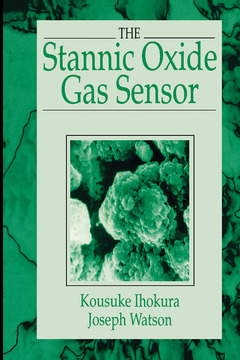The Stannic Oxide Gas SensorPrinciples and Applications Principles and Applications
Auteurs : Ihokura Kousuke, Watson Joseph

The Stannic Oxide Gas Sensor presents a comprehensive overview of the background science and technology of the subject, including practical information on its applications and the electronic circuits with which it is associated. The book explains the chemistry of the device and covers typical methods of fabrication. Sensitivity and selectivity are addressed, and the problems of drift with ambient temperature, relative humidity, and time are fully discussed.
The book also presents examples of industrial, commercial, and domestic applications. It explains the design of appropriate electronic circuits and describes methods for testing and characterizing sensors. Advantages and disadvantages of sensors are assessed as well.
Introduction 1.1 The Metal Oxide Gas Sensor 1.2 The Nature of Sensors -- 1.3 Early Gas Sensors 1.4 A Historical Note -- 1.5 Current Research and Development 1.6 The Taguchi Gas Sensor References Chapter 1 Fabrication of the Stannic Oxide Ceramic Sensor 1.1 Preparation of Stannic Oxide Powder -- 1.2 Gas Sensor Fabrication 1.3 The Binder and Sintering Process -- 1.4 The Final Active Material 1.4.1 Relationship between Stannic Oxide Crystal Size and -- Sensor Characteristics 1.4.2 The Sintered State of Stannic Oxide Ceramic 1.5 Basic Electrical Characterisation -- 1.5.1 Volt-Ampere Characteristics 1.5.2 Polarity -- 1.6 Basic Electrical Circuitry -- References Chapter 2 The Performance of the Stannic Oxide Ceramic Sensor 2.1 Conductivity versus Gas Concentration Characteristics -- 2.1.1 Gas Concentration Characteristics -- 2.1.2 Response Speeds 2.2 Sensitivity Variation with Temperature 2.2.1 Sensor Temperature Characteristics 2.2.2 Response Speeds — Further Observations -- 2.3 The Effects of Oxygen Partial Pressure and Humidity -- 2.3.1 Oxygen Partial Pressure -- 2.3.2 Water Vapor -- 2.4 The Effects of Variations in Preparation Modalities 2.4.1 The Effects of Calcining Conditions -- 2.4.2 The Effects of Sintering Conditions 2.5 The Mechanisms Underlying Sensitivity 2.5.1 The Surface Oxidation of Combustible Gases 2.5.2 Adsorbed Oxygen on the Sensor Surface -- 2.5.3 Gas Sensitivity -- 2.5.4 The Effect of the Crystal Surface on Gas Sensitivity -- 2.5.5 The Mechanism of Conductance Change 2.6 Transient Behaviour -- 2.6.1 The Initial Action Transient 2.6.2 The Long-Term Transient 2.7 Drift and Sensitivity -- 2.8 Drift with Time 2.8.1 Seasonal and Environmental Drift of Sensor Resistance in Gas 2.8.2 Long-Term Drift due to Atmospheric Contamination 2.8.3 Contamination Drift in Practice -- 2.8.4 Mechanisms of Contamination Drift -- References Chapter 3 Sensitivity Modification Using Additives 3.1 The Need for Additives -- 3.1.1 The Addition of Palladium 3.1.2 The Effect of Palladium on Sensitivity -- 3.1.3 The Effects of Palladium on Sensor Response Speed -- and Short-Term Transient 3.1.4 The Effects of Palladium on Gas Concentration -- Characteristics and Sensitivity -- 3.1.5 The Influence of Water Vapor on Sensors with Added Palladium 3.2 Basic Processes in Palladium-Doped Sensors -- 3.2.1 Palladium as an Oxygen Dissociation Adsorption Catalyst -- 3.2.2 Palladium as an Electron Donor or Acceptor -- 3.2.3 The Condition and Amount of Palladium Dopant 3.3 Other Additives 3.3.1 Noble Metal Additives -- 3.3.2 Further Additive Techniques -- References Chapter 4 Selectivity 4.1 The Problem of Selective Behavior -- 4.1.1 The Control of Relative Sensitivity via -- Sensor Operating Temperature 4.1.2 The Control of Relative Sensitivity Using Additives -- 4.2 Selectivity to Carbon Monoxide 4.3 Selectivity to Ammonia -- 4.4 Selectivity to Ethanol Vapor 4.5 Recent Work on Selectivity -- 4.5.1 Selectivity to Hydrogen Sulfide 4.5.2 Further Effects of Metal Oxide Additivies -- 4.6 Major Additive Techniques -- References Chapter 5 The Stannic Oxide Sensor as a Combustion Monitor 5.1 Methods of Monitoring Combustion Products 5.1.1 Fabrication of the Combustion Sensor 5.2.1 A Combustion Sensor Evaluation Method 5.2.2 Measured Sensor Characteristics 5.2.3 Temperature Dependency 5.2.4 Response Speed -- 5.2.5 Durability -- 5.3 Domestic Gas Heater Monitoring and Control References Chapter 6 The Domestic Gas Alarm 6.1 Introduction 6.1.1 Response to Methane 6.2 Requirements for a Domestic Gas Detector -- 6.2.1 Physical Requirements for a Domestic Gas Detector 6.2.2 Specific Requirements 6.3 Domestic Gas Alarm Design 6.3.1 Early Gas Alarm Circuits 6.3.2 Modem Electronic Circuits 6.3.3 Operational Design Factors for Domestic Gas Alarms 6.3.4 Some Manufacturing Considerations 6.4 Domestic Gas Alarms for Bottled Gas and Town Gas References Chapter 7 Industrial Gas Sensors and Instruments 7.1 Industrial Gas Sensors 7.1.1 Industrial Sensor Encapsulations 7.1.2 Structure of the Active Element 7.2 A Low-Level Carbon Monoxide Monitor 7.2.1 The Toxicity of Carbon Monoxide -- 7.2.2 A Low-Level Carbon Monoxide Sensor 7.2.3 Drive Requirements and Circuit Design for a Carbon -- Monoxide Monitor References Chapter 8 Future Developments 8.1 Advantages and Disadvantages of the Metal Oxide Gas Sensor 8.1.1 Advantages of the Stannic Oxide Gas Sensor 8.1.2 Disadvantages of the Stannic Oxide Gas Sensor 8.2 Potential Improvements 8.2.1 Improvements in the Sensor per se 8.2.2 Improvements in Sensor-Circuit Combinations 8.2.3 ‘Intelligent’ Sensors References Appendix Testing and Chracterization A.l Environmental Sensitivity of Sensors -- A.2 The Realization of Low Gas Concentrations A.2.1 Gas Sensitivity Characterization A.3 The Problems of Ambient Temperature and Humidity A.3.1 The Environmental Test Chamber A.4 User Calibration Reference Index.
Date de parution : 12-2020
15.6x23.4 cm
Thèmes de The Stannic Oxide Gas SensorPrinciples and Applications :
Mots-clés :
Stannic Oxide; resistance; Sensor Resistance; carbon; Gas Sensitivity; monoxide; Gas Sensor; concentration; Carbon Monoxide; sensitivity; Heater Voltage; temperature; Oxygen Partial Pressure; ethanol; Metal Oxide Gas Sensor; vapor; Gas Alarm; alarm; Sintering Temperature; oxygen; Application; Specific Integrated Circuits; Joseph Watson; Ethanol Vapor; Figaro Engineering; Sintering Strength; Excess Air Ratio; Scanning Electron Microphotograph; Oxide Gas Sensors; Crystallite Size; Hydrogen Sulfide; Sensor Ceramic; Humidity Dependency; Calcination Time; Sensor Conductivity; Adsorbed Oxygen; RV



